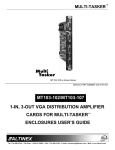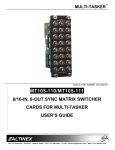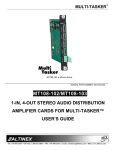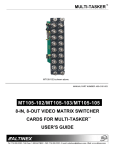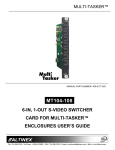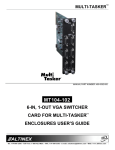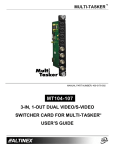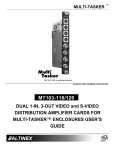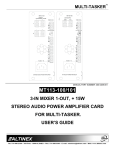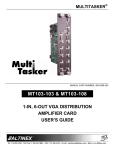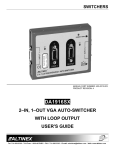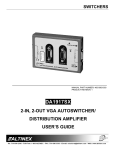Download Altinex MULTI-TASKER MT110-103 User`s guide
Transcript
MULTI-TASKER MT103-104 is shown above. MANUAL PART NUMBER: 400-0090-004 MT103-104/MT103-109/MT103-110 6-OUT VGA DISTRIBUTION AMPLIFIER TM EXPANSION CARDS FOR MULTI-TASKER ENCLOSURES USER’S GUIDE MULTI-TASKER TABLE OF CONTENTS Page PRECAUTIONS / SAFETY WARNINGS.............. 2 ABOUT YOUR MT VGA DA EXPANSION CARD ................................ ................................ .. 3 TECHNICAL SPECIFICATIONS.......................... 3 PRODUCT DESCRIPTION................................ .. 4 APPLICATION DIAGRAM................................ .... 4 INSTALLING YOUR MT VGA DA EXPANSION CARD ................................ ................................ .. 8 OPERATION (FOR MT103-104 ONLY)............... 8 7.1 RS-232 CONTROL...........................................8 7.2 RS-232 INTERFACE........................................8 7.3 DESCRIPTION OF COMMANDS.....................8 7.4 SUMMARY OF COMMANDS .........................12 TROUBLESHOOTING GUIDE........................... 13 ALTINEX POLICY................................ .............. 14 1 MULTI-TASKER PRECAUTIONS / SAFETY WARNINGS interference operation. 1 Please read this manual carefully before using your MT103-104/(109)(110) . Keep this manual handy for future reference. These safety instructions are to ensure the long life of your MT103-104/(109)(110) and to prevent fire and shock hazard. Please read them carefully and heed all warnings. • Handle the MT103-104/(109)(110) carefully. Dropping or jarring can damage the card. • Do not pull the cables that are attached to the MT103-104/(109)(110) . • Insert the card carefully into the slots of the Multi-Tasker™ without bending any edges. • When removing a card, please make sure that the card to which it is attached is also pulled out simultaneously. 1.3 CLEANING • Clean only the connector area with a dry cloth. Never use strong detergents or solvents, such as alcohol or thinner. Do not use a wet cloth or water to clean the card. Do not clean or touch any component or PCB. 1.4 FCC / CE NOTICE • This device complies with part 15 of the FCC Rules. Operation is subject to the following two conditions: (1) This device may not cause harmful interference, and (2) this device must accept any interference received, including 2 undesired • Any changes or modifications to the unit not expressly approved by ALTINEX, Inc. could void the user’s authority to operate the equipment. Qualified ALTINEX service personnel, or their authorized representatives must perform all service. To prevent fire or shock, do not expose this unit to rain or moisture. Do not place the MT103-104/(109)(110) in direct sunlight, near heaters or heat radiating appliances, or near any liquid. Exposure to direct sunlight, smoke, or steam can harm internal components. cause This equipment has been tested and found to comply with the limits for a Class A digital device, pursuant to Part 15 of the FCC Rules. These limits are designed to provide reasonable protection against harmful interference when the equipment is operated in a commercial environment. This equipment generates, uses, and can radiate radio frequency energy and, if not installed and used in accordance with the instruction manual, may cause harmful interference to radio communications. Operation of this equipment in a residential area is likely to cause harmful interference in which case the user will be required to correct the interference at his own expense. 1.2 INSTALLATION • may • 1.1 GENERAL • that MULTI-TASKER ABOUT YOUR MT VGA DA EXPANSION CARD (MT103-109 only) Approvals CE, FCC Table 1. MT103-104/(109)(110) General 2 MT103-104, MT103-109 & MT103-110 6-out VGA Distribution Amplifier Expansion Cards MECHANICAL MT103-104/(109)(110) Enclosure Slots Required Two Weight 0.6 lb. (0.27kg) Shipping Weight 1.1 lb. (0.5kg) Connector Panel Black T° Operating 10°C to 40°C T° Storage 0°C to 50°C Humidity 90% non-condensing MTBF (calc.) 40,000 hrs Table 2. MT103-104/(109)(110) Mechanical The MT103-104, MT103-109 and MT103-110 are 6-out VGA Distribution Amplifier Expansion Cards are designed to connect via a short internal cable to either the MT103-102 or MT103-103 in a MultiTasker enclosure. When installed along with a MT VGA DA Card in a MultiTasker enclosure, these MT VGA DA Expansion cards consume 2 slots and expand the number of outputs by 6. ELECTRICAL Output Video Signal For example, the MT103-104 used together with the MT103-102 provides a total of 9 VGA-type outputs. The MT103-104 used together with the MT103-103 provides a total of 12 VGA-type outputs. The MT103-104 can also pass RGBHV type signals if the outputs are adapted from 15-pin HD connectors to 5 BNC connectors using ALTINEX adapter cables. Analog Impedance Gain Crosstalk DC Offset Output Sync Signal Horizontal, Vertical Impedance Propagation Delay Rise/Fall Time DC Offset Frequency Compatibility Horizontal Vertical Bandwidth MT103-104, MT103-110 MT103-109 Power For high performance applications, the MT103-104 and MT103-110 have industry leading 350MHz bandwidth. Additionally, the MT103-104 provides “on-off control” of each output, augmented by Screen Blanking, which eliminates annoying signal loss messages by maintaining the Sync signal on all attached projectors and monitors. For the most economical configurations, the MT103-109 offers a low cost expansion solution for “always on” distribution, and solid 250 MHz bandwidth performance. TECHNICAL SPECIFICATIONS 3 MT103-104 FEATURES/DESCRIPTION MT103-104/(109)(110) GENERAL Inputs (1) Internal 10-pin IDC Input Connector + (1) cable (included) Outputs 6 Output Connectors 15-pin HD Female RGBS*, RGBHV* VGA Compatibility through QXGA (* requires the use of adapters, (MT103-104/110 only) see Optional Accessories) VGA through UXGA MT103-109 MT103-110 MT103-104/(109)(110) -.3V to +1.5V (1.5V p-p max.) 75 Ohms 1.05 -39dB @ 15MHz +/-20V max, input = 0V TTL (+/-) 22 Ohms 6nS max. 45nS max. +/-.1V max, input = 0V 15-200 kHz 20-180 Hz +6V 250 mA 270 mA 315 mA 350 MHz @ -3dB 250 MHz @ -3dB Power -6V Consumption 220 2.8 watts mA 120 2.4 watts mA 265 3.5 watts mA Optional Accessories MS8102CA 6ft, 15-pin HD-M to 5-BNC M MS8106CA 6ft, 15-pin HD-M to 5-BNC F Table 3. MT103-104/(109)(110) Electrical 3 MULTI-TASKER PRODUCT DESCRIPTION 4 APPLICATION DIAGRAM Application 1 4 5 MULTI-TASKER Application 2: Internal View of the MT VGA DA Expansion Cards 5 MULTI-TASKER Application 3: RGBHV Switching Use the MT103-104/(109)(110) card for RGBHV signals to display more than 6 monitors. You need one MT103-104/(109)(110) Expansion card and one MT103-102/(103) MT VGA DA card. 6 MULTI-TASKER Application 4: Connection of MT103-102/103 to MT103-104/109/110 7 MULTI-TASKER computer control system or any other device capable of sending RS-232 commands. INSTALLING YOUR MT VGA DA EXPANSION CARD 6 7.2 RS-232 INTERFACE Step 1. Connect the 10-pin IDC cable from the MT VGA DA Card (MT103-103/102) to the control port, P3 of the MT103-104/(109)(110) (see Application 4). Note this connection will provide RGBHV to the MT103-104/(109)(110) . The RS-232 commands for the MT103-104 are in a simple ASCII character format. Step 2. Slide the (previously connected) MT VGA DA Card (MT103-103/102) and the MT103-104/(109)(110) into available slots in the Multi-Tasker™ Enclosure. The VGA DA (MT103-103/102) will to connect to the bus. Make sure that the MT103-104/(109)(110) and the VGA DA Card (MT103-103) fit into place. Secure the cards to the Multi-Tasker™ by tightening the retainer screws located on the top and bottom of each card. The MT103-104/(109)(110) should be mounted to the right of the (MT103-103) VGA DA Card. Square brackets “[ ]” are part of the command. 2. Use uppercase letters for all commands. After processing a command, an OK or ER string will be returned as feedback if "F" is included at the end of a command string or if the unit ID is zero. Commands such as [ON], [OFF], and [IO] that end in "S" will be saved into memory. Commands not ending in "S" will still be executed but will not be restored when the system is reset (power off & power on again). 7.3 DESCRIPTION OF COMMANDS Each command consists of three parts: function, card ID, and unit ID. [Function, Card ID, Unit ID] Step 3. Connect a VGA cable from the video source to the input connector of the VGA DA Card (MT103-103/102). Connect the output of the MT103-104/(109)(110) to the display devices through a VGA cable. Example: [VERC3U2] VER = function C3 = Card ID U2 = Unit ID Step 4. Starting from the left, identify the slot number where the MT103-104/(109)(110) card is plugged into the Enclosure and note that it is for RS-232 control. OPERATION (for MT103-104 only) 1. For function, see a detailed explanation under each command description. 7 Card ID is an assigned value from 1 to 19 (1 to 8 or 1 to 4 depending on which enclosure is being used), which represents the number of slots. Card ID 0 (C0) is used for the controller (see user’s guide for the MT100-100). Changing the position of a card will significantly affect the commands recorded on software definitions or a third party control system. 7.1 RS-232 CONTROL The outputs of the MT103-109 and the MT103-110 are always enabled; therefore, no RS-232 control is necessary. When used in the Multi-Tasker™ Enclosure, the MT103-104 has many advanced remote control capabilities, which are accessible through standard RS-232 communication. The actual controlling can be accomplished through a Unit ID has a value from 0 to 9. Unit ID 0 should be used for single unit operation. If the Unit ID is set to 0, then each command can be used 8 MULTI-TASKER without Ui (use command [SETU0] ; see user’s guide for the MT100-100). If there is no card in slot #2 of unit 3, there will be no feedback. Example: 3. [CiS] [VERC3]: for unit ID zero [VERC3Ui]: for unit ID other than zero [VERC3]: equivalent to [VERC3U0] This command saves the current status of the card's input to output configuration. This configuration will be restored after system is reset or powered off then on. 1. [VER] Ci = card number S = save configuration This command displays the software version and card type for the MT103-104 card. If Inputs 1,2,3,4,5 and 6 are enabled, the feedback after sending the command [C4S], for slot 4, would be: Command Format: [VERCnUi] Cn = card ID No. (n = slot # from 1 to 19) ON:1,2,3,4,5,6 C04 Saved (1-8 for MT100-101 or 1-4 for MT100-106) Ui = Unit ID (i = # from 0 to 9) (refer to the MT100-100 user’s guide for explanation) 4. [SIGCi] To send command [VERC2U3], the MultiTasker™ Enclosure will return: The Signal Present command tests for the presence of an input signal on the input. After sending the command, the feedback will be either "1" signifying a signal is present, or "0" indicating no signal was detected. MT103-104 690-0125-009 i = Slot Number 690-0125-009 = software version MT103-104 = card number Example: Example: If one MT103-104 card is in slot #2 of unit 3: To check for the presence of an input signal on card 4, send the command [SIGC4] and verify feedback of "1" or "0". 2. [C] This command receives the status of the card. 5. [ON] Command Format: [CnUi] Cn = card id (n = slot # from 1 to 19) (1-8 for MT100-101 or 1-4 for MT100-106) This command enables one or more outputs of a single card or group of cards. Ui = unit id (i = from 0 to 9) (refer to the MT100-100 user’s guide for explanation) [ONmCnUiS]: for a single card This command enables output “m” without affecting any other outputs. Example: Default when plugged in = ALL OFF If one MT103-103 card is in slot #2 of unit 3 with output 1 and 2 ON, to send command [C2U3], the Multi-Tasker™ Enclosure will return feedback as: m = Output number (m = 1 to 6) Cn = Card ID number (n = 1 to 19) (1-8 for MT100-101 or 1-4 for MT100-106) ON:1,2 C02 Ui = Unit ID number (i = 0 to 9) ON:1,2 = outputs 1 and 2 enabled C02 = card 2 S = saves command to memory 9 MULTI-TASKER To enable output 1 of card 6 and output 3 of card 7 simultaneously, use the following commands: Example: 1) [ON12C5U3]: Turns ON only outputs 1 and 2 of the MT103-104 card located in slot #5 of the MT100-100 Enclosure with unit ID3. 2) [ON1C6U3P] [ON3C7U3P] [SW] [ON3C5U3]: Turns ON only output 3 of the MT103-104 card located in slot #5 of the MT100-100 Enclosure with unit ID3. After the [ON12C5U3] and [ON3C5U3] commands have been executed, outputs 1, 2 and 3 will be ON. 3) If "F" is included use the [ONmCnUiPF] command or the [ONmCnUiFP] command. [ON…..F]: feedback After processing a command, an OK or ER will be returned as feedback if "F" is included at the end of a command string or if the unit ID is zero. [ONC5U3]: Turns ON all outputs of the card. [ONmGkUiS]: for a group of cards This command enables output "m" for each card in group "k" of unit "i". Example: m = card output (m = # from 1-6) [ON1C2U3F]: if path is not set [ON1C2U3PF]: if path is set Gk = group number (k = # from 1-9) Ui = unit number (i = # from 0-9) 6. [OFF] S = saves command to memory Example: This command disables one or more outputs of a single card or a group of cards. 1. [OFFmCnUiS]: for a single card 2. [ON1G5U1]: Turns ON output 1 for each card in group 5 of unit 1. This command disables output “m” without affecting any other outputs. [ONG5U1]: Turns ON all outputs for each card in group 5 of unit 1. m = output number (m = 1 to 6) [ON…..P]: sets path Cn = card ID No. (n = slot # from 1 to 19) (1-8 for MT100-101 or 1-4 for MT100-106) This command will set the path for the output, but it is not active until the switch command is executed ( [SW] ). Commands ending in "P" are not executed immediately. The path for outputs on multiple cards or the same card can be loaded. Ui = Unit ID number (i = 0 to 9) S = saves command to memory [OFFCnUi]: Turns OFF all outputs of the card Example: Command Format: [ONmCnUiP] 1) If card 5 of unit 3 has output 1, 2 and 3 ON: m = output number (m =1 to 6) a) Cn = card ID No. (n = a slot # from 1 to 19) (1-8 for MT100-101 or 1-4 for MT100-106) [OFF1C5U3]: Turns OFF output 1 while output 2 and 3 remain ON. Ui= Unit ID number (i = 0 to 9) P = path Example: If 2 cards are in slot 6 and 7 of unit 3: 10 b) [OFF23C5]: Turns OFF output 2 and 3. c) [OFFC5U3]: Turns OFF all outputs, which is equivalent to [OFF123456C5U3] . MULTI-TASKER end of a command string or if the unit ID is zero. [OFFmGkUiS]: for a group of cards This command disables output "m" for each card in group "k" of unit "i". Example: m = card output (m = # from 1-6) [OFF1C2U3F]: if path is not set [OFF1C2U3PF]: if path is set Gk = group number (k = # from 1-9) Ui = unit number (i = # from 0-9) 7. […S] – Save S = saves command to memory This command will save the configuration command being sent in memory. When sending the command [ON1C4S], after reset or power up, output 1 on C4 will be enabled. Example: 1. [OFF1G5U1]: Turns OFF output 1 for each card in group 5 of unit 1. 2. [OFFG5U1]: Turns OFF all outputs for each card in group 5 of unit 1. 8. […P] – Path This command will set the path for the output, but it is not active until the switch command, [SW], is executed. Commands ending in "P" are not executed immediately. The path for outputs on multiple cards or the same card can be loaded. See examples in ON and OFF commands. [OFF…..P]: sets path This command will set the path for the output, but it is not active until the switch command is executed ( [SW] ). Commands ending in "P" are not executed immediately. The path for outputs on multiple cards or the same card can be loaded. 9. […F] – Feedback Command Format: [OFFmCnUiP] After processing a command, an OK or ER will be returned as feedback if "F" is included at the end of a command string or if the unit ID is zero. m = number (m =1 to 6) Cn = card ID No. (n = a slot # from 1 to 19) (1-8 for MT100-101 or 1-4 for MT100-106) 10. [SW] – Switch Ui = unit number (i = # from 0-9) The switch command immediately connects inputs and outputs, which were previously set with the path command on this card and all other cards in the MT100-100. P = path Example: If 2 cards are in slot 6 and 7 of unit 3, to enable outputs 1 and 2 of card 6 and outputs 3 and 4 of card 7, simultaneously use the following commands: The system will return feedback as OK. 11. [WR] [OFF12C6U3P] [OFF34C7U3P] [SW] This command groups multiple cards in the MT100-100 Enclosure. Each unit contains a maximum of nine groups. If "F" is included use the [OFFmCnUiPF] command or the [OFFmCnUiFP] command. Command Format: [WRCn…GkUi] Cn = card ID No. (n = slot # from 1 to 19) (1-8 for MT100-101 or 1-4 for MT100-106) [OFF…..F]: feedback Gk = group number (k = # from 1-9) After processing a command, an OK or ER will be returned as feedback if "F" is included at the Ui = unit number (i = # from 0-9) 11 MULTI-TASKER Example: (1-8 for MT100-101 or 1-4 for MT100-106) To group cards #1, 2, and 3 as group 5 of unit #1, send the command [WRC1C2C3G5U1]. After executing this command, cards 1, 2, and 3 of unit 1 will be grouped as group 5. Example: To read member data for group 1 of unit 1, send the [RD] command. The system will return feedback as C1C2C3 G5U1. 12. [CLR] 15. [HELP] This command clears the members for a single group or for all nine groups. This command displays all information available for user Multi-Tasker interface commands. Command Format: [CLRGkUi] 7.3 SUMMARY OF COMMANDS Gk = group number (k = # from 1-9) Ui = unit number (i = # from 0-9) Example: a) b) To clear group #1, send the [CLRG1U1] command. This command clears the members for the specified group only. To clear all groups of unit 1, send the [CLR G[U1] command. 1) [VER] Receives software version 2) [Ci] Receives status of the card 3) [CiS] Saves card configuration 4) [SIGCi] Check for input signal presence 5) [ON] Turns on one or more outputs for a single card or a group of cards 6) [OFF] Turns off one or more outputs for a single card or a group of cards 7) […S] Save the command configuration sent 8) […P] Sets the path, preload for [SW] 9) […F] Provides feedback upon sending 13. [G] This command is used to request group data. With the command, the user can identify which input or output of a particular group is on. Command Format: [GkUi] Gk = group number (k = # from 1-9) 10) [SW] Switch (outputs the preloaded buffer) Example: 11) [WR] Groups multiple cards If group 1 has DA Cards with output 1 and 2 on, while group 2 has SW Cards with input 2 on: 12) [CLR] Reset card configuration or clears members of a single group or all groups 13) [G] Requests group d ata 14. [RD] 14) [RD] This command displays the members in each group. Displays the members in each group 15) [HELP] Display all available commands Ui = unit number (i = # from 0-9) 1) [G1]: will return feedback as [On12G1]. 2) [G2]: will return feedback as [On2G2]. Command Format: [RDGkUi] Gk = group number (k = # from 1-9) Ui = unit number (i = # from 0-9) members = C1 - C19 (card 1 to 19) 12 MULTI-TASKER TROUBLESHOOTING GUIDE Solution 2: Take any other known good card with an LED and verify that the slot used is good by seeing if the other card’s LED lights in that slot. If it lights, then the original card may be the source of the problem. Call ALTINEX at (714) 990-2300. 8 We have carefully tested and have found no problems in the supplied MT103-104/(109)(110) ; however, we would like to offer suggestions for the following: 8.1 LED IS NOT LIT Cause 1: Solution 1: Solution 2: Cause 1: Look at the card and verify that there is no damage. If there is no damage, see Solution 2. Call ALTINEX at (714) 990-2300. Cause 2: The MT103-104/(109)(110) card and its serial device are not communicating. Solution 2: Verify that all IC’s are seated in their sockets. If the LED is still blinking red, see Solution 3. Solution 3: Call ALTINEX at (714) 990- 2300. Cause 2: Turn the system OFF and then ON again. If there is still an error, see Solution 3. Solution 2: Call ALTINEX at (714) 990-2300. Cause 3: RS485 communication error Solution 1: Make sure that the card is pushed all the way into the slot. The CPU on the card is not working properly. Solution 1: Look at the card and verify that there is no damage. If there is no damage, see Solution 2. Verify that all IC’s are seated in their sockets. If there is still an Solution 3: Solution 1: 8.2 LED ON CARD IS BLINKING RED The CPU on the card is not working properly. The MT103-104/(109)(110) card and its serial device are not communicating. Solution 1: Turn the system OFF and then ON again. If there is still an error, see Solution 3. Solution 2: Call ALTINEX at (714) 990-2300. Cause 3: RS485 communication error Solution 2: Turn the system OFF and then ON again. If there is still an error, see Solution 3. Solution 1: Make sure that the card is pushed all the way into the slot. If there is still an error, see Solution 2. Solution 3: If there is still a problem, call ALTINEX at (714) 990-2300. Cause 4: Card cage slot has a problem. Solution 2: Turn the system OFF and then ON again. If there is still an error message, see Solution 3. Solution 3: If there is still a problem, call ALTINEX at (714) 990-2300. Solution 1: Test the card in other slots of the card cage. If the slot was damaged, the card may work in other slots. If other slots work and the LED lights, the problem is the card cage slot. The card cage may require service. Call ALTINEX at (714) 990-2300. If the other slots do not work and the LED is still not lit, see Solution 2. 8.3 NO DISPLAY 13 Cause 1: The source has a problem. Solution: Check the source and make sure that there is a signal present and all source connections are correct. If the source is working and there is still no display, see Cause 2. MULTI-TASKER Cause 2: The card output is turned OFF. ALTINEX POLICY Solution 1: Turn ON the card output that is used. See RS-232 accessible commands in section 7. If no display is present, see Cause 3. Cause 3: Cable connections to destination are incorrect. Solution: Make sure that cables are connected properly. Also, make sure that the continuity and wiring are good. If there is still no display present, see Cause 4. Cause 4: 9 9.1 LIMITED WARRANTY / RETURN POLICY Please see the Altinex website at www.altinex.com for details on warranty and return policy. the 9.2 CONTACT INFORMATION ALTINEX, INC 592 Apollo street Brea, CA 92821 USA TEL: 714 990-2300 The display has a problem. TOLL FREE: 1-800-ALTINEX Solution 1: Make sure that the display is powered. If there is still no display, call ALTINEX at (714) 990-2300. WEB: www.altinex.com E-MAIL: [email protected] 14















